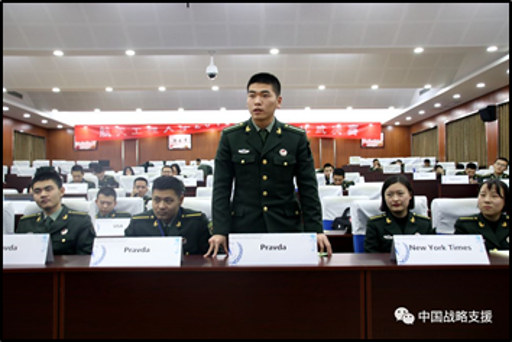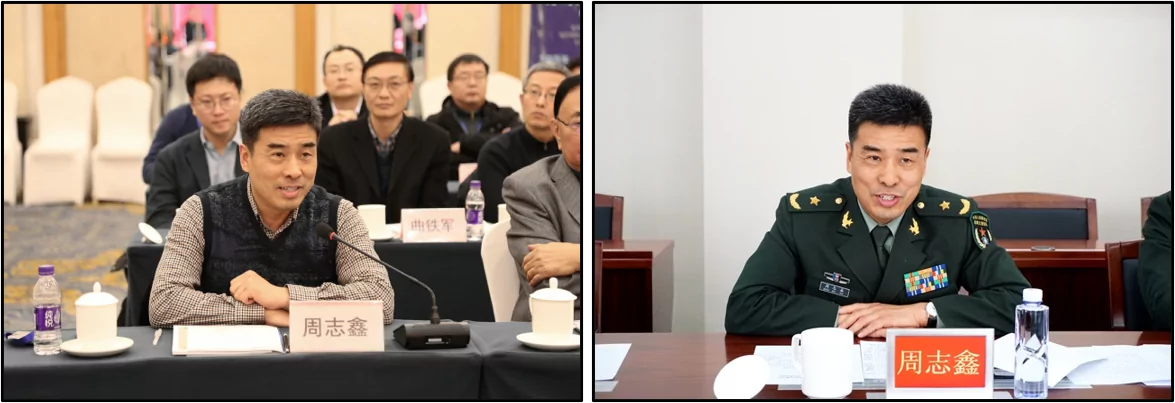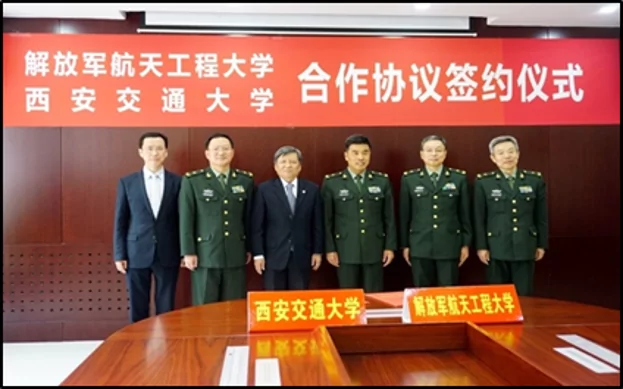
The Role of the Space Engineering University in the PLA Strategic Support Force
Publication: China Brief Volume: 20 Issue: 13
By:

Introduction
Almost five years after the establishment of the PLA Strategic Support Force (PLASSF) in December 2015 (China Brief, December 21, 2016; China Brief, May 29, 2019), many questions remain regarding the scope and strength of the force. However, publicly-available recruitment information and admission data released by the PLA Strategic Support Force Space Engineering University (中国人民解放军战略支援部队航天工程大学, Zhongguo Renmin Jiefang Jun Zhanlue Zhiyuan Budui Hangtian Gongcheng Daxue) or SEU, one of the two military academic institutions known to be directly subordinate to the PLASSF, offers useful insights (81.cn, June 13, 2019). [1] Examination of SEU’s structure and programs offers insights into the academic and technical expertise, as well as military skills, that the SSF looks to cultivate in its future officer and non-commissioned officer (NCO) corps. This article provides an overview of the SEU and its relationship to the PLASSF, and calls for the PLA-watching community to continue monitoring how the PLA and PLASSF leverage their resources to facilitate China’s broader military-civil fusion (MCF) goals (China Brief, October 8, 2019). [2]
SEU (Ministry of Education code: 91036), located on three campuses in Beijing, is subordinate to the PLASSF Space Systems Department (81.cn, October 27, 2017). However, unlike almost all of the other military academies of the PLA, which have the service name in front of the institution name—as with Air Force Aviation University—this subordination relationship is not always visible across its official logo, banners, or admissions materials. Instead, various sources have showed or referred to this corps deputy-leader grade military academic institution as the PLASEU—or simply, SEU.
To highlight its special status, Major General Zhou Zhixin (周志鑫), the commandant of the SEU since 2017, has described his university as a military institution established on “the decision of Chairman Xi Jinping and the Central Military Commission (CMC).” [3] It is perhaps no coincidence that Major General Zhou is a renowned Chinese Academy of Sciences (CAS) academician who pioneered China’s remote-sensing technology and its satellite applications (PLA Daily, 14 January 2016). Prior to joining SEU in 2017, Zhou likely also served as the director of the Space Reconnaissance Bureau of the former General Staff Department’s (GSD) Second Department (2PLA), which was transferred to the PLASSF in 2017 (Peng Pai News, 9 April 2016; Sohu, 8 October 2017; CTTIC, 22 February 2017; CSNC, undated).

SEU as a Component of the National Defense “Special Innovation Zone” Program
Since 2019, SEU has hosted a designated “workstation” (工作站, gongzuo zhan) for the National Defense Science and Technology (S&T) Special Innovation Zone (国防科技创新特区, Guofang Keji Chuangxin Tequ) program (Shenzhen.gov.cn, April 16, 2020; Zhanlue Qianyan Keji WeChat, April 4, 2020). This is possibly a research funding program of the Science & Technology Innovation Bureau (科技创新局, Keji Chuangxin Ju) of the CMC Science & Technology Commission (军委科技委, Junwei Kejiwei) (Anhui University, July 2018). [4] It is unclear what the specific responsibilities of the workstation are, but it is most likely designed to facilitate targeted research on spatial information technology (空间信息技术, kongjian xinxi jishu) (Dalian University of Technology website,16 October 2019; Xinhua, 13 October 2019), which covers pivotal technologies for modern military decision-making such as remote sensing and Geographic Information System (GIS) technologies. [5]
Dating back to at least 2017, a number of civilian universities have reportedly received significant funding from this Special Innovation Zone program to carry out both classified and unclassified research projects. [6] However, none of the other recipients appear to host such a “workstation” on campus. [7] Such a model suggests that a high degree of autonomy is awarded to the lab/workstation, which may be conducive to innovation.
SEU is also known to house at least two defense-related national key labs: the National Key Laboratory of Laser Propulsion and Applications (激光推进及其应用国家重点实验室, Jiguang Tuijin jiqi Yingyong Guojia Zhongdian Shiyanshi) and the National Laboratory of Electronic Information Equipment Systems (电子信息装备体系研究国防科技重点实验室, Dianzi Xinxi Zhuangbei Tixi Yanjiu Guofang Keji Zhongdian Shiyanshi) (PRC Government, 9 May 2012). [8] Nevertheless, it remains unclear how or if any connections exist between the key labs and the relatively new “innovation workstation.”
SEU as a “Joint Construction” University for Military Research
Official descriptions of SEU presented in 2019 and 2020 mention another “new status” for the university: SEU as a “joint construction” (共建, gongjian) university” between the State Administration for Science, Technology and Industry for National Defense (国家国防科技工业局, Guojia Guofang Keji Gongye Ju) or SASTIND, and the PLASSF (81.cn, June 13, 2019; Central South University, April 2, 2020; Huangpu Yihao WeChat, June 3, 2020). Limited information is available about the details of this relationship. The purpose of such “joint construction” universities, according to SASTIND, is:
[T]o focus on the development of disciplines and specialties that are applicable to national defense, the construction of national defense key laboratories (国防重点学科实验室, guofang zhongdian keji shiyanshi), and the training of military talents; to take advantage of the “joint construction” universities’ specialties and undertake military research tasks; encourage and support universities and military industrial enterprises to strengthen collaborative innovation in production, teaching, and research; actively promote joint construction of universities to build up world-class disciplines and become world-class academic institutions (Lanzhou Daily, August 2, 2018).
If similar “joint construction” relationships formed between SASTIND and a number of civilian academic institutions can be used as a reference, this likely also implies that SEU plays a significant role in implementing MCF in the realm of defense technologies.
SEU’s Partnerships with Civilian Universities and Research Institutions
SEU has established formal faculty exchange programs with Beijing University and the Beijing University of Aeronautics and Astronautics, as well as guest lecture programs with CASC, CASIC, CAS, and the Chinese Academy of Engineering (CAE). Formal “strategic partnerships” have also been formed between SEU and the University of the Chinese Academy of Science, which allows curriculum sharing and credit transfers (PLASSF WeChat, June 14, 2018). [9]
Most notably, in April 2019 SEU also signed an official cooperation agreement with Xi’an Jiaotong University. Both parties pledged to cooperate in the areas of “talent cultivation, scientific research and academic affairs, talent recruitment, and admission promotions” (Xi’an Jiaotong University, April 20, 2019). The signing ceremony was held on SEU’s Huairou campus in Beijing and was attended by key leaders from both universities, suggesting the potential significance of this partnership. The group picture taken after the ceremony provided a rare look at the key SEU leaders, including: Major General Zhou Zhixin, the Commandant; Major General Zhang Changsheng (张长生), the Political Commissar; Major General Zhao Hongli (赵洪利), Vice Commandant and Dean for Education; and Major General Zheng Huaizhou (郑怀洲), Vice Commandant. [10]

In addition to these formalized relationships, SEU also sponsors other mechanisms, such as the “Yanqi Space Forums” (雁栖太空论坛, Yanqi Taikong Luntan), to deepen its connections with experts and relevant stakeholders in the space industry and academia, both inside and outside of the PLA (PLA Daily, October 13, 2019). To date, SEU has hosted two Yanqi Space Forums in 2018 and 2019; as a result of the COVID-19 pandemic, it remains unclear whether the third one will be held in the fall of 2020. It also remains to be seen whether SEU and the other organizers plan to open up the forum to foreign participants in the future.
SEU’s international outreach programs are less clear. In 2019, through the PLA’s civilian personnel (文职人员, wenzhi renyuan) recruitment efforts, it reportedly hired at least three instructors/staff who received their graduate degrees from foreign universities: Nanyang Technological University (Singapore), the University of London, and the University of Pennsylvania (PLASSF WeChat, March 7, 2018; PLA Daily, March 6, 2018). In an interview with the PLA Daily in 2019, Dong Zhenghong (董正宏), director of the Office of Scientific Research and Academic Affairs, revealed that he visited foreign countries without providing further details (PLASSF WeChat, February 25, 2019).
Educating China’s Future Space Soldiers
What is the quality of the cadets enrolled at SEU, and what kind of education are they receiving? As the sole military academic institution responsible for educating China’s future space fighters, SEU’s curriculum prioritizes knowledge about space engineering and information countermeasures, as well as intelligence processing and analytical skills (PLA Daily Wechat, June 13, 2018). The curriculum has largely remained the same since SEU’s founding in 2017. Cadets are offered abundant opportunities—through both required coursework and extracurricular activities—for receiving Science, Technology, Engineering and Math (STEM) education; however, what and how cadets are taught about leadership and command skills remains unclear.
When it comes to admissions through the Chinese Gaokao, or college entrance exam system, SEU, like other military academies (along with a handful of civilian universities attached to government agencies), is placed in the “Binding Early Decision” (提前批, tiqian pi) category. This is an effective way to ensure that such institutions receive a certain number of the “best and brightest” high school graduates, whose high Gaokao scores would otherwise qualify them to be admitted to more prestigious civilian universities. Using 2018 and 2019 admissions data in Beijing as a sample, the table below provides a rough comparison of the scores of admitted SEU students against those of peers admitted to Tsinghua University and the National University of Defense Technology (国防科技大学, Guofang Keji Daxue) (NUDT)—a top civilian and a top military academic institution, respectively, both of which are known for their STEM specialties. For simplicity’s sake, considering that SEU’s curriculum is heavily STEM-focused, this comparison only looks at the admission scores of the “science track” (理科, li ke) and does not take into consideration the “humanities track” (文科, wen ke). [11]
Table 1: Gaokao University Admission Exam Scores for SEU, NDUT, and Tsinghua Students
| 2017 | 2018 | 2019 | ||||
| Highest | Average | Highest | Average | Highest | Average | |
| SEU | 606 | 590.8 | 619 | 594.6 | 619 | 575.5 |
| NUDT | 648 | 620 | 659 | 634 | 646 | 628 |
| Tsinghua | 671 | N/A | 685 | N/A | 681 | N/A |
Source: Data compiled by the author based on a variety of publicly-available Chinese sources, including: dxsbb;zhihu; Tsinghua.edu; China Education online; NUDT website.
This rough comparison by no means provides a conclusive assessment for the overall quality of the young cadets in the pipeline to become China’s future space soldiers. It should also be noted that the size of SEU’s student body is much smaller than those of either NUDT or Tsinghua. [12] However, this data does show that, despite the small increase in admission scores of its admitted students over the past three years, there remains a rather large gap between the young talents that SEU attracts and other top institutions. Although no official data on the admission rate is currently available, given its smaller size and relatively lower name recognition, SEU’s admission ratio is also likely higher than the other universities, suggesting a less-selective admission process. It remains to be seen whether the upward trend in SEU’s admission Gaokao scores continues in the coming years.
Conclusion
PLA-watchers who track and study China’s military space programs, as well as the PLASSF, should pay close attention to the activities of the Space Engineering University. SEU is not only an academic institution through which the PLA trains its future space warfighters; it also functions, by design, as a center of space innovation and a hub of research and development for the PLASSF. More importantly, evidence gathered for this article suggests that SEU likely serves as a premier testing ground among PLA academic institutions for the concepts of military-civil fusion. The mechanisms through which SEU engages and mobilizes civilian space resources will likely serve as a model for other institutions.
Dr. Marcus Clay is an analyst with the U.S. Air Force’s China Aerospace Studies Institute (CASI). The views expressed are those of the author, and do not reflect the official policy or position of the U.S. Air Force, Department of Defense, or other agencies of the U.S. Government.
Notes
[1] The other university is the SSF Information Engineering University (信息工程大学, Xinxi Gongcheng Daxue) [Ministry of Education code: 91037], which is subordinate to the PLASSF Network Systems Department.
[2] For existing literature on the SEU in English, see: Ken Allen, PLA Military Academic Institutions, Section 6-36,CASI, 2020. Marcus Clay, Supporting the Infinite Battlefield, CASI, 2019. pp. 16-19. Also see: “Space Engineering University,” https://unitracker.aspi.org.au/universities/space-engineering-university/, ASPI, 2019.
[3] “Xi’an Jiaotong University and PLASEU Sign Cooperative Partnership Agreement” (西安交大与解放军航天工程大学签署合作协议) Xian Jiaotong University website (April 20, 2019). https://news.xjtu.edu.cn/info/1002/111642.htm.
[4] There are at least three “rapid response small groups for defense innovation” (国防科技创新快速响应小组, guofang keji chuangxin kuaisu xiangying xiaozu)—in Dalian, Shenzhen, and Chongqing—that have been created to facilitate the agenda of the Special Innovation Zone and possibly other programs spearheaded by the S&T Innovation Bureau (Dalian.gov, 12 March 2020).
[5] For a brief introduction to the applications of GIS technologies, see: https://www.esri.com/library/brochures/pdfs/gis-for-defense.pdf.
[6] To name a few, Anhui University (安徽大学), https://kjc.ahu.edu.cn/dd/ed/c12345a187885/page.htm; College of Computer Science and Technology (计算机科学与技术学院), Jilin University (吉林大学), https://www.jiocalls.com/info/1261/11224.htm; College of Electronics Engineering (电子工程学院), Xi’an University of Posts and Telecommunications (西安邮电大学), https://news.xupt.edu.cn/info/1002/16734.htm. Hefei University of Technology (合肥工业大学), https://gfzby.hfut.edu.cn/2017/1114/c2118a105528/page.htm
[7] To date, the only other known such “innovation workstation” was created at the Qian Xuesen Laboratory of Space Technology (钱学森空间技术实验室, Qian Xuesen Kongjian Jishu Shiyanshi) on January 29, 2018 (QXSLab, undated). This latter institution was housed within the China Academy of Space Technology (CAST), also known as the 5th Academy (五院, Wu Yuan) of China Aerospace Science and Technology Corporation (CASC). According to the lab, this workstation is a pilot project to test out new “management models for defense technology innovation” and its operations will be based on a new funding model of “overall investment, full trust, full authorization, independent management, flexible adjustment, [and] ex-post evaluation” (QXSLab, February 2, 2018).
[8] For more on these two labs, see: https://web.archive.org/web/20191009035229/https://souky.eol.cn/news/takeinfo/935/53218.html.
[9] The University of CAS (UCAS) was previously known as the Graduate School of CAS. It was renamed in 2012 before it expanded to recruit undergraduate students in 2014. For more details, see: https://english.ucas.ac.cn/index.php/about-ucas/history.
[10] Judging from their ribbons, all of the key leaders of SEU appear to hold the same rank of Major General (少将, shao jiang) and same grade of corps deputy leader (副军职, fu junzhi). It is an unusual setup, which likely results from the 2016 downgrading of the SEU/Equipment College from a corps leader grade (正军级, zheng junji) to a corps deputy leader grade (副军级, fu junji) organization during the military reform. Major Generals Zheng and Zhao were likely already in the corps deputy leader grade before Major Generals Zhou and Zhang were assigned to SEU. On a day-to-day basis, the SEU leadership likely functions in accordance with their administrative positions, not their military grades.
[11] Admission cutoff scores in the Gaokao system vary by locality. For instance, for the same university and same major, a high school graduate from Beijing will be evaluated against a different score—usually set by government education commissions—from a student graduating from a high school in Hubei Province. Almost all Chinese high schools divide their students during junior year into either a “science track,” with more emphasis on STEM-courses, or a “humanities track,” which requires coursework on history, politics, and geography. Students then are required to take different subject tests for the Gaokao.
[12] As of 2020, there were a total of 16,037 (including 1,198 international students) students enrolled in Tsinghua’s undergraduate programs (https://www.tsinghua.edu.cn/xxgk/tjzl.htm). In 2019, NUDT had roughly 8,400 undergraduate students, including 1,530 cadets (https://www.cingta.com/detail/11666). However, SEU’s 2019 admission data shows that it had an undergraduate student body of only 373 cadets (https://zhuanlan.zhihu.com/p/136156315).



